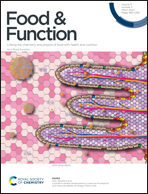Anti-obesity effects of red seaweed, Plocamium telfairiae, in C57BL/6 mice fed a high-fat diet
Abstract
This study aimed to demonstrate the anti-obesity effect of Plocamium telfairiae (PT), a red seaweed. Different percentages of ethanol (0%, 20%, 40%, 60%, 80%, and 100%) were used for the preparation of PT extract. Furthermore, 3T3-L1 cells were used to determine the percentage of ethanol for optimal anti-adipogenesis of PT, and the anti-obesity properties of the optimized extract of PT (PTE) (40%) was assessed in obese mice. The results indicate that 40% ethanol extract (40 PTE) significantly decreased fat accumulation and suppressed the expression of major adipogenesis factors such as peroxisome proliferator-activated receptor-γ (PPAR-γ), sterol regulatory element-binding protein 1 (SREBP-1), CCAAT/enhancer-binding protein (C/EBP)-α, and phosphorylated ACC (pACC) in 3T3-L1 cells. Furthermore, in the high-fat diet-induced obese mice, 40 PTE significantly reduced the weights of white adipose tissue, as well as the levels of triglyceride, total cholesterol, adiponectin, and insulin in the serum. Liver histopathology showed that steatosis decreased in all the PTE treatment groups. The adipogenesis-related proteins, PPAR-γ and SREBP-1, were also significantly decreased in PTE treatment groups. Additionally, 40 PTE increased mRNA expression of mitochondrial uncoupling proteins (UCP)-1 and UCP-3 in brown adipose tissue. These findings provide evidence that 40 PTE can alleviate lipid droplet accumulation in 3T3-L1 adipocytes and obese C57BL/6 mice, indicating that PTE has strong anti-obesity effects and could be used as a therapeutic agent or a component of pharmaceutical drugs and functional foods.



 Please wait while we load your content...
Please wait while we load your content...